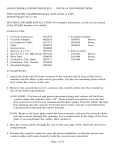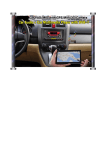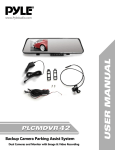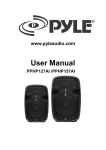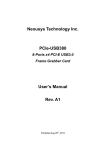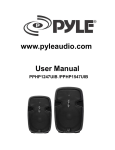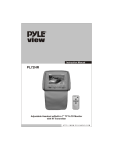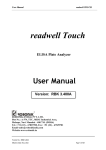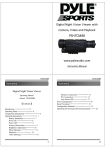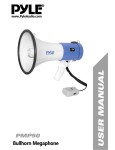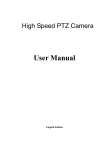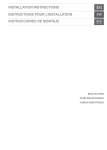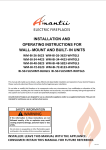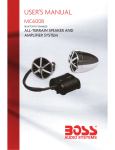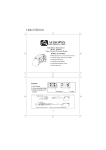Transcript
Owner's Manual Page 2 WNER'S MANUAL PVCKT5 www.pyleaudio.com This volume control is designed to run multiple pairs of speakers without damaging your amplifier or receiver. The adjustment is made by using bridge clips that can be easily changed. NOTE: Both bridge clips must have the sam e setting - i.e. 1x, 2x or 4x. Failure to properly set the bridge clips may result in damage to your amplifier or receiver. Please follow the recommendations in this section carefully. Failure to properly set the bridge clips may result in damage to your amplifier or receiver. Use the chart in Figure #4 to determine a ) the maximum number of speaker pairs that can be connected to your amplifier or receiver and b) the appropriate bridge clip setting (1 x, 2x or 4x) to use on the volume control. Impedance Matching Stereo Volume Control In troduction This is a wall mounted impedance matching stereo volume control, which connects between the speaker level output of an amplifier, receiver or speaker selector and a pair of speakers. Volume Control Placement When deciding where the volume control will be mounted in the wall, consider the various ways it will be used. The primary listening area and the ease of running the wire to your chosen location are the important things to keep in mind. The most common locations to mount volume controls are by the door as you walk into the room, next to existing wall fixtures, or in the area that you will be listening to music. If you do not understand any part of these instructions, please contact your system dealer. Improper wiring could cause damage to your audio system. Do not put the volume control into the same box as a 110v AC circuit. (i. e. light switch, electrical outlet, etc.). Speaker wires can act as an "antenna" for electrical noise. Locating speaker wires too close to a light switch or dimmer may cause a buzzing or popping sound to be heard through the speakers. If you must locate the volume control near electrical devices, use a separate electrical box. 1. In the first column, determine the minimum impedance capability Number of Bohm Speaker Pairs of your amplifier or receiver. 2. Move across the row to the number of 80hm speaker pairs you wish to use. 3. The resulting number (1 x, 2x or 4x) is the bridge clip setting appropriate for your configuration. NOTE: Both bridge clips must have the same setting. 4. The gray area indicates a setting that is slightly below the amplifier or receiver 's minimum impedance but will most likely work. Figure #4 Figure #1 Figure #5 -~'"-' 111 Once a location has been chosen, you may install the volume control after you have first installed a standard single gang plaster ring, or a single gang electrical box (light switch type) . // IIt~Ch ..... " • • I ~ IFl. 0Il. ~ Mounting the Volume Control W / /' l c . Il. Il. 11"'''''. 1 OL. Ol. Once the control has been wired, it is ready to be mounted in to the wall. Referring to Figure #5, place the components of the volume control into the wall in the order illustrated. Use the enclosed screws to hold the components in place. STEP 1 STRIP SPEAKER OR AMPUFIER WIRE'S INSULATI O N TO 1/ 4" FROM THE END AND INSERT INTO PROPER SLOT SPEAKER WIRE / NOTE: The rotary switch is shipped with the control turned as far counterclockwise as it will turn off. If you changed this, return it to the full counterclockwise position before starting installation. vsr4 5 VOLUME CONTROL Wiring the Volume Control (supplied) CAUTION: Please make sure your amplifier or receiver is turned off before proceeding. DECORATOR PLATE (supplied) STEP 2 TIGHTEN WIRE CLAMP KNOB (supplied) SCREW WITH SC REWDRIVER DECORATOR COVER PLATE (supplied) ~ COVER PLATE SCREWS (supplied) This volume control can be used with up to 14-gauge wire. Measure the distance from the speaker to the amplifier. For distances of 50 feet or less, use 18-gauge speaker wire or ordinary lamp cord. For distances greater than 50 feet, use heavier 16-gauge wire. For best results, strip the speaker wire no more than 114" from the end. Loosen the screws on the underside of the wire block terminal to allow the wire to be pushed completely into the opening, then tighten the screws to secure the wire. (See Figure #1). If you need to remove the wire, simply loosen the screws on the underside of the wire block terminal. Figure #2 SPEAKERS •• AMPLIFIER Speaker Outputs RRLL + . + - RIGHT LEFT • • INPUT WIRES Refer to Figure #2 when wiring the volume con t rol: 1. Connect the amplifier or receiver s left speaker output to the left input terminals on the removable wire block terminal. Please observe proper polarity of the connections (+ amplifier to + input on the volume contron. OUTPUT WIRES 2. Repeat step 1 for the right side . SIDE VIEW VOLUME CONTROL 3. Connect the wires from the left speaker to the left speaker output terminals on the wire block terminal. Please observe proper polarity of the wires for correct speaker phase (+ speaker to + output). 4. Repeat step 3 for right speaker connection. CAUTION: If the input and output connections are reversed, the minimum setting on the volume control will cause a short across the amplifier or receiver output terminals, resulting in serious damage to your amplifier or receiver. Please double check steps 1 through 4. This volume control cannot be connected in series with another volume control. Adjusting the Bridge Clips for Multi ple Speakers (See Figure #3) Figure #3 2x 1x Setting Setting 4x Setting Both Clips on Top (1x) Pins Both Clips on Midd le (2x) Pins Both Clips on Bottom (4x) Pins

